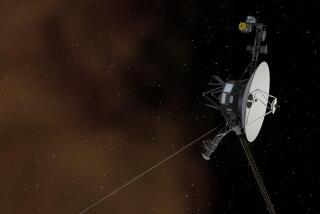Voyager Team Still Not Sure Fuel Will Last
- Share via
MOJAVE — Fuel worries surfaced again Sunday in the globe-circling flight of the aircraft Voyager, and project planners said they are no longer certain that the spindly craft can make it home before its engines consume the last of the gas.
Burt Rutan, the plane’s designer and brother of co-pilot Dick Rutan, said all attempts to make precise fuel calculations had gone awry. Their best estimates now put the Voyager’s reserves at “marginal” levels, Rutan said.
Other concerns also began to weigh on team members here as the aircraft approached the last leg of its journey. Rutan said increasing pilot fatigue and predicted head winds could affect the ultimate outcome.
‘Not Over Yet’
“Film at 11, guys; it’s not over yet,” Rutan told a midmorning briefing.
If the gas holds out, the Voyager is now expected to arrive at its take-off point, Edwards Air Force Base, sometime Tuesday afternoon. The base will be opened to the public six hours before the landing.
Late Sunday, the aircraft, carrying Dick Rutan and co-pilot Jeana Yeager, was approaching the coast of Central America in smooth weather. The flight plan now calls for Voyager to cross Central America and turn north along the west coast of Mexico as it heads home.
Mechanically the plane was reported to be operating well but project meteorologist Glen Snellman said Voyager unexpectedly encountered the worst turbulence yet Saturday as it flew across the mid-Atlantic.
A sudden storm caught the meteorologists and pilots by surprise and whipped the crafted so strongly that Rutan momentarily lost control. Several times the plane was turned on its side so that the wings were vertical rather than horizontal; at another point the craft was turned 90 degrees off course.
Reason to Be Scared
For a time, Burt Rutan said, “The weather was flying the airplane. I’m sure he (Dick Rutan) will admit he was scared.”
The danger of further storms forced the Voyager to turn south in a longer and more fuel-expensive route across the Atlantic. As it made the corrections Saturday afternoon, workers here attempted to calculate, once again, how much fuel remains in the plane.
The problem stems from a mechanical glitch in the small fuel counters aboard the plane that are supposed to measure the amount of gasoline burned. In mid-flight it was discovered that some gas traveled backward through the fuel counters, as well as forward. That fuel was counted twice by the devices.
If a large amount of fuel was counted twice, Voyager is fat, Rutan said. But he does not believe that is the case.
“We believe there was only a minor flow-back,” he said. In that case, Voyager’s reserves are marginal, he said.
May Just Be Gliding
“It may just barely glide into Edwards with its engines out of gas. We don’t know,” Rutan said.
Adding to the problems, meteorologist Snellman has predicted 20 m.p.h. head winds for today’s leg of the journey along the Mexican coast. Head winds force the plane to use more gas.
The uncertainty will not go on forever. Rutan said the fuel supply system in the plane is set up to reveal exactly when the craft is down to 43 gallons of gas. At that point, he said, the crew will know whether Voyager will complete its journey.
Planners here have also begun to worry about the effect that extreme fatigue will have on the pilots’ ability to land the plane if conditions are less than ideal. The ungainly Voyager is difficult to land, especially in high winds.
Effects of Fatigue
Officials revealed Sunday that the pilots occasionally have been so fatigued that they could not read data from the plane’s instruments when asked to do so. At other times Rutan and Yeager have seemed fresh, they reported.
To protect the craft and its crew from harassment by sight-seeing aircraft in the United States, the Federal Aviation Administration has prohibited other aircraft from approaching Voyager as it nears home. Officials here said their own chase planes would report any violators to the FAA.
More to Read
Sign up for Essential California
The most important California stories and recommendations in your inbox every morning.
You may occasionally receive promotional content from the Los Angeles Times.










